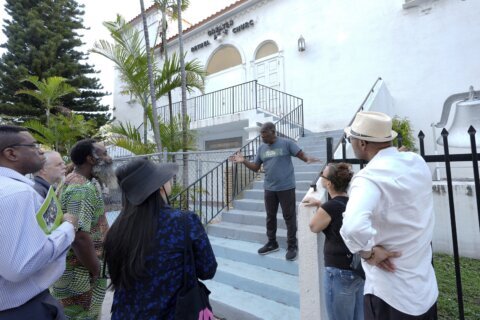
As a sizzling summer comes to a close, students and teachers across the U.S. could be returning to hot classrooms at schools that are not equipped to deal with sweltering temperatures.
Large portions of the country have been placed under heat alerts and warnings over the summer, with many people struggling to stay cool at home or unable to pay high electric bills, risking their power being shut off. Meanwhile, schools across the country — many with students scheduled to return in August — are scrambling to keep buildings cool, with experts saying aging infrastructure and budget woes are contributing factors.
Around 36,000 schools nationwide need heating, ventilation and air conditioning updates, the Government Accountability Office found in a 2020 report, the most recent statistics available. And it’s a problem that isn’t just prevalent in traditionally hotter parts of the country, but also in cooler-weather climates, said Joseph Allen, director of Harvard University’s Healthy Buildings Program.
“We saw the heat dome across the U.S. this summer and this is just the beginning of extreme heat,” he said. “A major problem is that schools in traditionally cool-weather climates are not prepared. In fact, many of these schools were built to retain heat.”
In Philadelphia, 90 schools were forced to close early in June because of heat. The district has taken action to mitigate hot weather concerns at the start of the school year, said Oz Hill, the district’s chief operating officer. The start date for the upcoming school year was moved from late August to Sept. 5 “to reduce the likelihood that extreme temperatures would impact our ability to provide in-person instruction.”
Schools on the West Coast have also been forced to close early when dealing with excessive heat.
“We’ve underinvested in school infrastructure in our country for at least four decades and we de-prioritize the importance of a healthy school building on teacher health and student health,” Allen said.
There are around 100,000 public schools in the U.S. The American Society of Civil Engineers gave the building conditions in schools an overall grade of D+. According to the most recent report card, the best estimates indicate an annual funding gap for public school facilities across the country of at least $38 billion.
In a 2020 study, the Center for Climate Integrity estimated that by 2025, 156 school districts — serving nearly 1.3 million students — will see at least 30 more days over 80 degrees Fahrenheit during the school year than they did in 1970. California, Colorado, Illinois, Iowa, Massachusetts, Michigan, New Jersey, New York, Ohio and Pennsylvania will each face more than $1 billion in new cooling equipment costs by 2025, according to the center. Researchers also found that Idaho, Indiana, Maryland and Utah will face $500 million each in added school air conditioning equipment costs by 2025.
About 28% of all public schools were built before 1950, and 45% of all public schools were built between 1950 and 1969, according to government data. But much of the infrastructure wasn’t designed for extreme heat, such as the temperatures many parts of the U.S. have seen in recent years.
“The climate’s changing fast and our buildings are not. Our buildings are not keeping up,” Allen said.
In Arizona, which regularly deals with unrelenting heat, many students returned to school in mid-July, and almost all districts will be back in session by the end of this week, according to the Arizona Education Association. High heat in the 90s and above 100 degrees Fahrenheit starts in May and continues through September, giving districts little choice but to start the school year when it’s still hot out.
“The thought was ‘if we open up earlier, this will allow some of these students who do not have air conditioning at home at least a place of safety in a school,'” Arizona Education Association president Marisol Garcia said.
And problems can start even before the school day begins because many students walk to school.
“A mile when it’s already 90, 92 degrees in the morning is a lot for those kids,” Garcia said. “It’s a hike and that’s fine, but then they’re going to come to school dehydrated, they’re going to come to school sweaty, they’re going to come to school already tired.”
When it’s too hot out, students may not be able to leave their classrooms for recess or lunch, Garcia said. That means that they will miss out on physical activity and chances to see friends from other classes. Their teachers, who will need to stay in the classroom with them, will also lose planning time.
In some situations, schools get hot enough that students are sent home, forcing them to miss out on valuable learning time.
Students learning in hotter environments tend to learn less and perform more poorly on tests, according to a study published in the American Economic Journal. Researchers looked at temperature data and the standardized test scores of 10 million students between 2001 and 2014. They found that without air conditioning, a 1-degree Fahrenheit hotter school year reduces that year’s learning by about 1%. Heat can also lower students’ ability to concentrate and make them feel tired. School air conditioning appears to offset 73% of the learning impact of hot school days for the average student.
An opportunity to change the situation arrived during the COVID pandemic. President Biden’s American Rescue Plan included allocating about $170 billion in funds for schools. The funds were to be used to reduce class size, modify space and improve ventilation, but Allen says the money isn’t being used properly.
“We have had hundreds of billions of stimulus dollars directed at schools. It’s irresponsible that that money has not been spent towards improving ventilation, filtration, cooling,” he said.
Meanwhile, Allen is pushing for investment in ventilation, filtration and cooling to ensure students and teachers are working in comfortable and safe environments. He said he wouldn’t put a dollar amount on the price of updating school buildings but instead emphasized that the focus should be on the cost of having kids out of school.
“Better air quality in schools is associated with better reading scores, better math test scores, fewer asthma attacks, teachers out less often,” he said. “This is an absolute no-brainer. It’s not hard, it’s not expensive and there are multiple benefits to student health, student thinking, student performance.”








